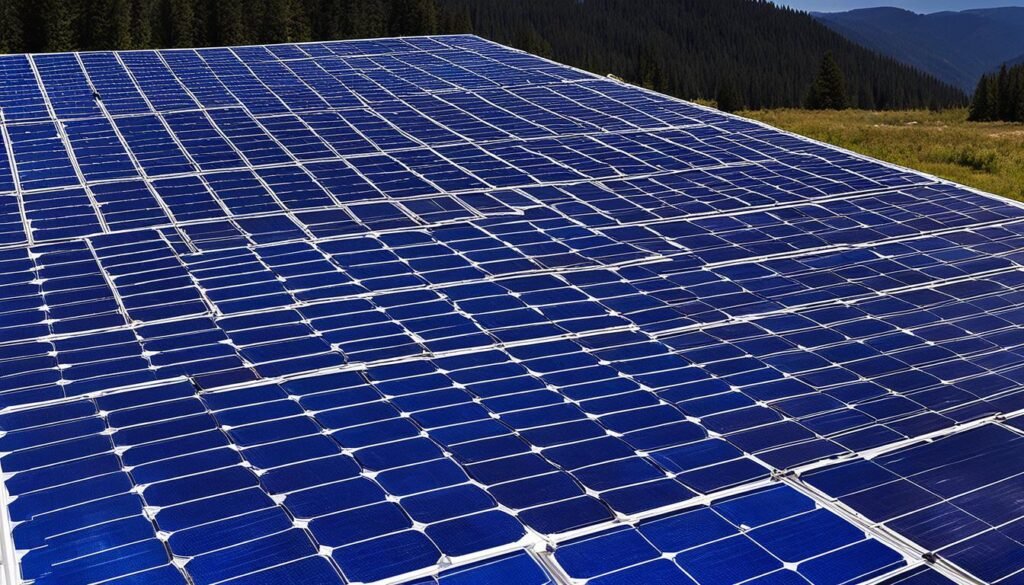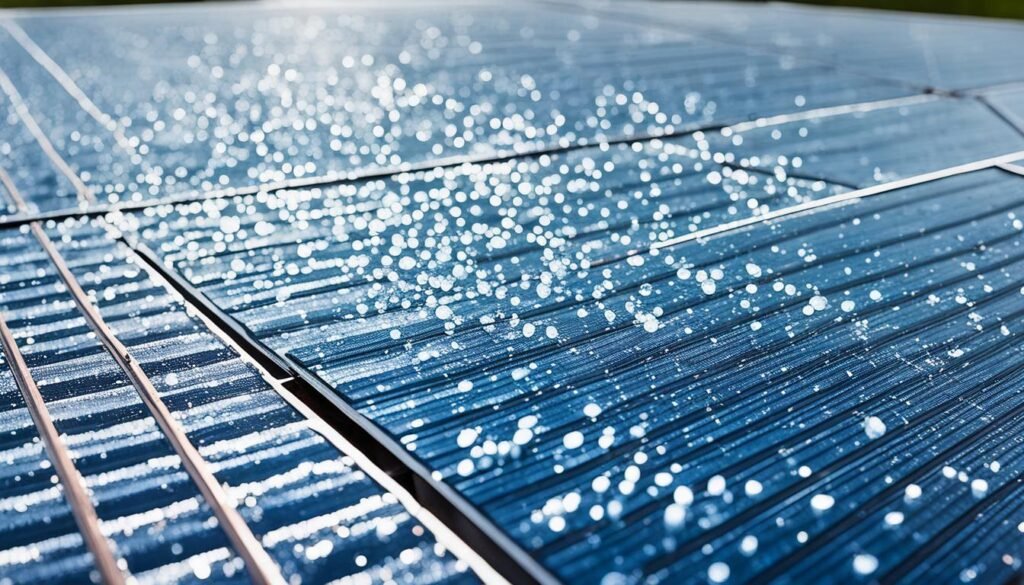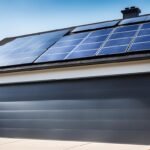Can thin film solar panels revolutionize our approach to eco-friendly power generation?
Are we on the cusp of a sustainable energy revolution? Thin film solar panels could be the answer. With their efficient design, they stand out from traditional panels. They’re packed with advanced solar technology to fight climate change.
These panels offer a blend of efficiency and affordability. They’re making a big impact in solar power and sustainable living. As their efficiency gets better, they become a more appealing option. This marks a new chapter in our energy future.
Key Takeaways
- Thin film solar panels offer unique benefits for sustainable energy sources.
- They play a crucial role in advanced solar technology aimed at mitigating climate change.
- Efficiency varies by material type, highlighting different applications and advantages.
- Market growth indicates a positive outlook for eco-friendly power generation.
- Understanding their efficiency helps in recognizing their potential and limitations.
Introduction to Thin Film Solar Panels
Thin film solar panels are a big step forward in making solar power widely available. They are light and can be used in many ways, making them a go-to choice for home solar power setups. They play a vital role in using clean energy and living sustainably.
What Are Thin Film Solar Panels?
Thin film solar panels fall under photovoltaic technology, turning sunlight into electricity. Unlike traditional panels made with thick silicon, thin film panels use far thinner layers. This makes them flexible, light, and suitable for a variety of surfaces.
History and Evolution
The journey of thin film solar panel technology started in the 1970s. That time was marked by efforts to find efficient and green energy options. Years of improvements have made thin film solar panels more efficient and affordable, leading to their growth in the market.
Importance in Renewable Energy Solutions
Thin film solar panels are incredibly important for renewable energy. They help move us towards using sustainable energy solutions. They are key in cutting down greenhouse gas emissions and our dependence on fossil fuels, making them a crucial part of alternative energy systems.
Types of Thin Film Solar Panels
Thin film solar panels come in several types. Each has its own special traits and advantages. Let’s look at four key types: amorphous silicon, cadmium telluride, copper indium gallium selenide, and organic photovoltaics.
Amorphous Silicon (a-Si)
Amorphous silicon (a-Si) was the first thin film technology to be made. It is important in the field. It can bend, which means it can go on curved surfaces. You can find it in solar calculators and backpacks. But, it’s not as efficient as other materials.
Cadmium Telluride (CdTe)
Cadmium telluride (CdTe) panels are known for being cost-effective and efficient. They make solar energy for less money than other technologies. However, cadmium is a toxic metal. This raises environmental and safety concerns that need careful handling.
Copper Indium Gallium Selenide (CIGS)
Copper indium gallium selenide (CIGS) panels excel in turning sunlight into electricity efficiently. This technology is flexible, fit for many uses. Although very efficient, making it costs quite a bit compared to other types of thin film tech.
Organic Photovoltaics (OPV)
Organic photovoltaics (OPV) use organic materials. They are eco-friendly and could be made cheaply. Their efficiency and lifespan are currently low. But, research is ongoing to make them better and viable for the market. Their light weight and flexibility are great for new uses.
Below is a summary of the main features of each thin film solar panel type:
| Type | Efficiency | Advantages | Disadvantages |
|---|---|---|---|
| Amorphous Silicon (a-Si) | Low | Flexible, lightweight | Lower efficiency |
| Cadmium Telluride (CdTe) | Moderate | Cost-effective | Environmental concerns |
| Copper Indium Gallium Selenide (CIGS) | High | High efficiency | High production costs |
| Organic Photovoltaics (OPV) | Low | Eco-friendly, lightweight | Lower efficiency, shorter lifespan |
The Production Process of Thin Film Solar Panels
The production of thin film solar panels is a look into cutting-edge solar technology.
Each step is carefully planned to make the panels efficient and durable. We’ll go through these phases, showing why each one is key to making high-quality, lasting solar energy.
Substrate Preparation
The first step is about getting the substrate ready. Glass or flexible plastics are often used because they’re stable.
This stage is vital as it creates the base for the semiconductor layers, guaranteeing they stick well and are consistent in the finished product.
Semiconductor Layering
After preparing the substrate, the next step is to add semiconductor materials to it. This core phase uses techniques like chemical vapor deposition.
The proper types and amounts of layers, such as silicon or cadmium telluride, are crucial for capturing and converting energy efficiently.
Electrode Attachment
Now, we attach electrodes to help the electric current flow. This step is fundamental, as it boosts the panel’s energy transfer capabilities.
The electrodes are made of thin metal films and placed to ensure the best electrical flow with least resistance.
Protective Encapsulation
The last phase is protective encapsulation. This cover protects the fragile semiconductor and electrode layers from things like moisture and sun damage.
It’s an essential step for sustainable energy products, making the panels more durable and long-lasting.
These stages highlight the complexity of solar technology. Each part is crucial for creating effective and durable thin film solar panels. They all contribute to the larger aim of sustainable energy production.
Efficiency Comparison: Thin Film vs Traditional Solar Panels
When choosing efficient solar panels, comparing our options is key. This section looks into the efficiency, cost-effectiveness, and space needs of thin film versus traditional solar panels.
Efficiency Metrics
Traditional solar panels are often more efficient, with rates between 15% to 20%. Thin film panels have an efficiency of 10% to 12%. But thin film panels do better in low light and high temps. They make up for their lower efficiency in certain conditions.
Cost-Effectiveness
Thin film panels are usually cheaper to make. They are great for big projects where the initial cost matters a lot. Traditional panels may cost more at first but are more efficient and stable over time. This can be a plus, depending on your project’s needs and location.
| Aspect | Thin Film Panels | Traditional Panels |
|---|---|---|
| Efficiency | 10% – 12% | 15% – 20% |
| Cost | Lower | Higher |
| Performance in High Temperatures | Better | Decent |
| Low-Light Performance | Better | Good |
Space Requirements
Thin film panels need more space to produce the same power as traditional ones. But, they can be put on many surfaces. They are perfect when you have lots of room or need portable power sources.
Choosing between thin film vs traditional solar panels depends on your needs. Cost, space, and climate play a big role. Both types have their benefits, with thin film panels bringing unique advantages.
Factors Affecting Thin Film Solar Panels Efficiency
Understanding how different factors influence thin film solar panel efficiency is key to better performance. These include the materials used, environment, and how precisely they are made.
Material Choices
The effectiveness of thin film solar panels greatly depends on the semiconductor materials used. Cadmium telluride (CdTe) and copper indium gallium selenide (CIGS) lead to highly efficient panels. Each material’s unique properties affect the panels’ efficiency and environmental footprint.
Environmental Factors
Temperature and humidity significantly impact thin film solar panels. High heat lowers their output, while the right humidity keeps them working well. By keeping an eye on these conditions, we can keep our solar panels running smoothly and eco-friendly.
Manufacturing Methods
The way thin film solar panels are made also matters. Precise methods in layering materials and attaching electrodes can boost their performance. Better manufacturing techniques mean more effective solar panels for our clean energy needs.
Various Applications of Thin Film Solar Panels
Thin film solar panels are used for many things. They can be bent and are lightweight. This makes them perfect for many uses.

Residential
Thin film solar panels look good on houses. They have a smooth design that people love. Plus, they’re easy to put on different spots, making homes energy-smart.
Commercial Buildings
In the business world, thin film panels are a great choice. They fit well on big roofs, making the most of the area for energy. This helps businesses cut down on power costs and be more eco-friendly.
Building-Integrated Photovoltaics (BIPV)
BIPV is a cool way to use thin film solar panels. They blend into building materials like windows. This makes buildings power themselves and brings new styles to architecture.
Automotive Integration
Cars are getting an upgrade with thin film solar panels. Toyota is working on solar-powered cars. They put the panels on the roof to help power things like the AC and charge batteries. This makes electric cars go further and work better.
Durability and Lifespan of Thin Film Solar Panels
Thin film solar panels are known for their impressive durability. They can last from 10 to 20 years. This varies by type and environmental conditions.
These panels are more durable than traditional ones. Their slow degradation rates mean they last longer. This makes them a top choice for sustainable, long-lasting solar power.
Many factors affect how long solar panels last. Temperature changes, humidity, and physical damage can impact their performance. Yet, in good conditions, these panels exceed expectations, providing reliable energy for years.
The table below shows how thin film panels compare to traditional ones in lifespan and degradation rates:
| Type of Solar Panel | Average Lifespan (Years) | Annual Degradation Rate (%) |
|---|---|---|
| Amorphous Silicon (a-Si) | 10-15 | 0.8-1.0 |
| Cadmium Telluride (CdTe) | 15-20 | 0.5-0.7 |
| Copper Indium Gallium Selenide (CIGS) | 15-20 | 0.5-0.7 |
| Traditional Crystalline Silicon (c-Si) | 25-30 | 0.5-0.8 |
Thin film solar panels are both cost-effective and durable. They’re a good choice for anyone wanting long-lasting solar solutions. As this technology gets better, these eco-friendly options will stay relevant for a long time.
Weather Impact on Thin Film Solar Panels Efficiency
Weather plays a huge role in how well thin film solar panels work. Elements like temperature and rain greatly influence their power production. Let’s explore how different weather conditions affect these panels.

Effects of Temperature
Extreme temperatures can really affect solar panel efficiency. Thin film panels handle heat better than traditional ones, thanks to their adaptive solar technology. This tech helps keep performance from dropping too much when it gets hot. Still, very high temperatures can make the panels wear out faster, which reduces their efficiency over time.
Weather Conditions
Clouds and rain also impact panel efficiency. Thin film panels are good at using light even on cloudy days. But, heavy rain can lower their effectiveness for a while because the water blocks the light. These panels can quickly adjust to changing light, which is great for places with varied weather.
We can’t ignore weather when thinking about solar panel efficiency. It’s key to know how these factors affect panels to make the most of them in different places.
Conclusion
As we look back, thin film solar panels are key in sustainable energy growth. They are getting better thanks to new materials and methods. They are light, flexible, and cost-effective, suited for many places like homes and cars.
The future of solar technology looks promising. There is a lot of work being done to make thin film solar panels more efficient and durable. By tackling their limitations, we’re making it easier for everyone to use them. This will lead to greener, cheaper solutions for our energy needs.
Solar energy, and thin film technology, in particular, helps us choose a cleaner future. Using these techs, we reduce our environmental impact and set up success for the next generations. The path forward is exciting as we keep improving and using solar power for a better planet.

